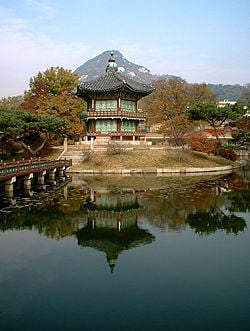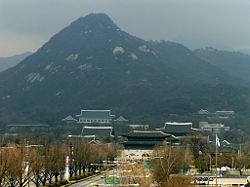Gyeongbokgung
| Gyeongbokgung | ||||||||
|---|---|---|---|---|---|---|---|---|
 | ||||||||
| Korean name | ||||||||
|
History
Built during the Joseon Dynasty, Gyeongbokgung (Gyeongbok Palace) is the main and largest palace of the Joseon Dynasty and one of the Five Grand Palaces. In 1911, the government of Japan demolished all but ten buildings during the period of Korea under Japanese rule, constructing the Japanese General Government Building, Seoul for the Governor-General of Korea in front of the throne hall. There are no known photos of the site before the demolitions took place.
Description
Jeong Do-jeon, a renowned Korean architect, designed the palace in norther Seoul. Originally constructed in 1394, Japanese forces burnt down the palace during the Japanese invasions of Korea (1592-1598). Reconstructed during 1860s to the original, massive size of 330 buildings with 5,792 rooms, the complex covered 4,414,000 square feet (410,000 square meters). Gyeongbokgung stoods as a symbol of majesty for the Korean people and the home of the royal family. Soon after the assassination of Empress Myeongseong by the Japanese agents in 1895, her husband, Gojong of Korea left the palace and the imperial family never returned.
National Treasures No. 223 and 224
The major buildings on the site include Geunjeongjeon, the Imperial throne room (National treasures of South Korea No. 223), and Gyeonghoeru Pavilion (National treasures of South Korea No. 224), which stands in an artificial lotus lake and rests on forty-eight granite pillars. The pavilion is depicted on the South Korean 10,000 won bill.
Today the palace is open to the public, and the National Folk Museum of Korea is located on the site. The National Museum of Korea was there too, until it was relocated to Yongsan-gu in 2005.
Many Koreans still hope to resurrect part of the original palace. Archeological work has brought 330 building foundations to light. However, the original magnificence of the palace may never be fully restored. Fortunately, the main gate into the palace called Gwanghwamun is now being restored to its original state to be completed in 2009.
The Blue House
The back garden of the Palace used to contain the main part of the Governror-General's residence during the Japanese era. With the establishment of the Republic of Korea in 1948, President Syngman Rhee used it as his office and residence. In 1993, after President Kim Young-sam's civilian administration was launched, the Japanese governor-general's residence in the Cheong Wa Dae compound was dismantled to remove a major symbol of the Japanese colonial occupation.
Gallery
ReferencesISBN links support NWE through referral fees
- Haeoe Hongbowŏn (Korea). Guide to Korean cultural heritage. Elizabeth, NJ: Hollym 2003. ISBN 9781565912137
- Lee, Gil-sang. Exploring Korean history through world heritage. Seongnam-si: Academy of Korean Studies 2006. ISBN 9788971055519
- Suh, Jai-sik. World heritage in Korea. Elizabeth, NJ: Hollym. 2001. ISBN 9781565911710
External links
- Official guide from Cultural Heritage Administration Retrieved June 23, 2007.
- Gyeongbok Palace Retrieved June 23, 2007.
- 영이 Retrieved June 23, 2007.
- Video of Royal Gate Ceremony, Gyeongbokgung Retrieved June 23, 2007.
- The Architecture and Skyscraper Community of Korea (English translated) Retrieved June 23, 2007.
| The "Five Grand Palaces" of Joseon-Dynasty Seoul |
|---|
| Changdeokgung | Changgyeonggung | Deoksugung | Gyeongbokgung | Gyeonghuigung |
Credits
New World Encyclopedia writers and editors rewrote and completed the Wikipedia article in accordance with New World Encyclopedia standards. This article abides by terms of the Creative Commons CC-by-sa 3.0 License (CC-by-sa), which may be used and disseminated with proper attribution. Credit is due under the terms of this license that can reference both the New World Encyclopedia contributors and the selfless volunteer contributors of the Wikimedia Foundation. To cite this article click here for a list of acceptable citing formats.The history of earlier contributions by wikipedians is accessible to researchers here:
The history of this article since it was imported to New World Encyclopedia:
Note: Some restrictions may apply to use of individual images which are separately licensed.













